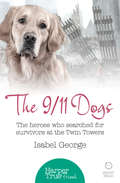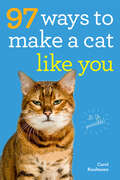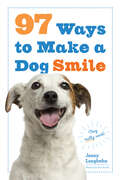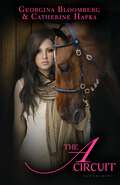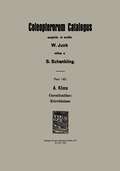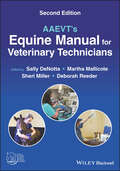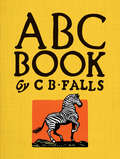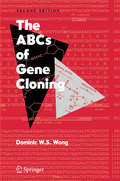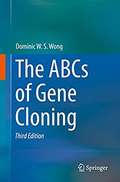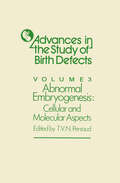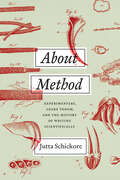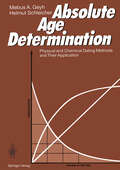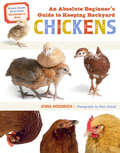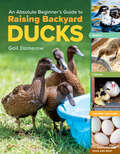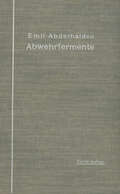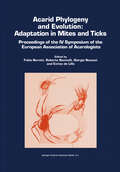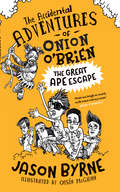- Table View
- List View
The 9/11 Dogs: The Heroes Who Searched For Survivors At The Twin Towers (HarperTrue Friend – A Short Read)
by Isabel GeorgeMeet the dogs who searched for life amongst the ruins of the Twin Towers.
97 Ways to Make a Cat Like You
by Carol KaufmannFrom the publisher of B. Kliban&’s Cat, All I Need to Know I Learned from My Cat, and Bad Cat, comes a new book that answers the question all cat lovers ask: How do I make my cat like me?97 Ways to Make a Cat Like You is the perfect interactive guide to these mysterious, fickle, seemingly aloof—yet really, just particular—pets. Paired with a full-color photograph of friendly, extroverted, happy cats (in case you&’ve forgotten what a cat looks like when he &“likes&” you), the 97 inspired, occasionally silly but always behaviorally-based tips and tricks prove that when a cat is treated right, he or she will respond in kind. Within reason. There&’s the &“Eye on the Ball&”—record a tennis match or a Ping-Pong game on TV to play back for your cat when he needs a bit of exercise. &“Cat Burrito&”—wrap your cat in a towel, burrito-style, which is particularly good for anxious pets or trips to the vet. The &“Boing, Boing!&”—wind pipe cleaners around a pencil in a spiral shape to create springs. Carefully slide off the pencil so the spirals go &“boing&” when pressed. The classic &“Tickle, Tickle&”—tickle Kitty under her chin and softly say &“gitchy, gitchy, gitchy&” in your highest-pitched voice. And for the cat owner willing to go the distance, the &“There&’s No Business Like Show Business&”—practice your best Ethel Merman by belting out favorite show tunes for your cat. Kitty won&’t care if you&’re off-key and she&’ll enjoy the stimulation.
97 Ways to Make a Dog Smile
by Jenny LangbehnNews for dogs and dog lovers to smile about: The irresistible bestseller is now even more irresistible with a 4-by-6-inch &“chunky&” format. As quirky, colorful, and giftable as ever, 97 Ways to Make a Dog Smile is now fresher and more appealing. Developed by Jenny Langbehn, a veterinary nurse who has a gift for making dogs happy, here are 97 foolproof methods and tricks for putting any dog into a state of pure pleasure. Enhancing each entry is an adorable, full-color photograph of the guaranteed result—a smiling dog. Give these a try: Lower-Ear Noogies. The Thumper. Lazy Man&’s Tetherball. The Hansel and Gretel—&“For an afternoon of fun, scamper about the house leaving a trail of plain popped popcorn in your wake.&” Or &“Subliminal Game,&” which works by sneaking a favorite word like &“cookie&” into otherwise boring jabber.* The tricks require no fancy props or special talents—just a willingness to surrender yourself to sheer silliness. They combine the creative gift of touch— unexpected ways to rub, massage, scratch, tickle, and knead—with imaginative play scenarios that are just loopy enough to ensure your dog will be amused, whether he&’s laughing with you or at you. These tricks really work.*Don&’t forget to have said cookie on hand.
The A Circuit: An A Circuit Novel (The A Circuit)
by Catherine Hapka Georgina BloombergThe A Circuit is the top of the top when it comes to horse showing. It's a world with its own rules and super-privileged lifestyles. Teens employ private tutors so they can travel the circuit all year showing horses that cost as much as some people's homes.Tommi, Kate, and Zara are all elite competitors on the circuit, but they come from totally different backgrounds. Tommi is a billionaire heiress trying to prove she has real talent (not just deep bank accounts). Kate puts the working in working student-every win has been paid for with hours of cleaning stalls. She's used to the grueling schedule, but Fitz, the barn's resident hot guy, is about to become a major distraction. And then there's Zara. She's the wild child of a famous rockstar, but she's ready to take riding seriously. Can a party girl really change her ways?Readers who enjoy peeking into the elite world of series of Gossip Girl or The A-List will feel right at home in this new series with its friendships, drama, and privilege set against a backdrop of competitive horseback riding.
AAEVT's Equine Manual for Veterinary Technicians
by Sally DeNotta Martha Mallicote Sheri Miller Deborah ReederAAEVT’s Equine Manual for Veterinary Technicians Practical handbook on all aspects of veterinary care in horses relevant to veterinary technicians AAEVT’s Equine Manual for Veterinary Technicians, Second Edition offers a compendium of information on the care and treatment of horses for equine veterinary technicians, building on the basics of equine care to provide a complete reference for equine nursing skills, training, and technical information. The text is specifically geared toward those who already have basic equine knowledge and training and are looking to build upon their foundations. Comprehensive yet accessible, the new edition updates all medical, procedural, pharmaceutical, equipment, staffing, and office management information. Images also appear in full color throughout the book for the first time. Chapters cover a variety of topics ranging from general horse management and nutrition to diagnostics and medical emergencies. Charts, tables, and images support the text to aid in reader comprehension. Sample topics covered in AAEVT’s Equine Manual for Veterinary Technicians include: General horse management, equine nutrition, applied anatomy and physiology, equine reproduction, and equine wellness programs Foal care, equine pharmacology, laboratory diagnosis in equine practice, equine anesthesia, surgical assistance, and nursing care Technical procedures, diagnostic procedures, common equine medical emergencies, equine physical rehabilitation, equine behavior, and equine office procedures An overall explanation of procedures and medical information regarding the care of horses in a clinic or ambulatory practice Highly accessible and easy to use, AAEVT’s Equine Manual for Veterinary Technicians, Second Edition is an invaluable reference for qualified equine veterinary technicians and assistants—particularly those earning their equine certification—as well as vet tech students and equine practices.
AAEVT's Equine Manual for Veterinary Technicians
by Sally DeNotta Martha Mallicote Sheri Miller Deborah ReederAAEVT’s Equine Manual for Veterinary Technicians Practical handbook on all aspects of veterinary care in horses relevant to veterinary technicians AAEVT’s Equine Manual for Veterinary Technicians, Second Edition offers a compendium of information on the care and treatment of horses for equine veterinary technicians, building on the basics of equine care to provide a complete reference for equine nursing skills, training, and technical information. The text is specifically geared toward those who already have basic equine knowledge and training and are looking to build upon their foundations. Comprehensive yet accessible, the new edition updates all medical, procedural, pharmaceutical, equipment, staffing, and office management information. Images also appear in full color throughout the book for the first time. Chapters cover a variety of topics ranging from general horse management and nutrition to diagnostics and medical emergencies. Charts, tables, and images support the text to aid in reader comprehension. Sample topics covered in AAEVT’s Equine Manual for Veterinary Technicians include: General horse management, equine nutrition, applied anatomy and physiology, equine reproduction, and equine wellness programs Foal care, equine pharmacology, laboratory diagnosis in equine practice, equine anesthesia, surgical assistance, and nursing care Technical procedures, diagnostic procedures, common equine medical emergencies, equine physical rehabilitation, equine behavior, and equine office procedures An overall explanation of procedures and medical information regarding the care of horses in a clinic or ambulatory practice Highly accessible and easy to use, AAEVT’s Equine Manual for Veterinary Technicians, Second Edition is an invaluable reference for qualified equine veterinary technicians and assistants—particularly those earning their equine certification—as well as vet tech students and equine practices.
AAEVT's Equine Manual for Veterinary Technicians
by Deborah ReederAAEVT's Equine Manual for Veterinary Technicians offers a compendium of information on the care and treatment of horses for equine veterinary technicians. Highly accessible and easy to use, the book builds on the basics of equine care to provide a complete reference for equine nursing and technical skills. AAEVT's Equine Manual for Veterinary Technicians is an invaluable guide for qualified equine veterinary technicians and assistants, particularly those earning their equine certification, vet tech students, and equine practices.
AAEVT's Equine Manual for Veterinary Technicians
by Deborah Reeder Sheri Miller DeeAnn Wilfong Midge Leitch Dana ZimmelAAEVT's Equine Manual for Veterinary Technicians offers a compendium of information on the care and treatment of horses for equine veterinary technicians. Highly accessible and easy to use, the book builds on the basics of equine care to provide a complete reference for equine nursing and technical skills. AAEVT's Equine Manual for Veterinary Technicians is an invaluable guide for qualified equine veterinary technicians and assistants, particularly those earning their equine certification, vet tech students, and equine practices.
Aardvark (Large Print)
by RnibThis page shows an image of a side view of an animal with its head on the left of the page and a tail on the right of the page. There is a locator dot shown, which will be at the top left of the page when the image is the correct way up. The head is long and thin with a tiny mouth in the bottom left of the page. One of its two large tubular ears is shown at the top of its head in the left centre of the page. To the right of the head is its arched hairy body which fills the page. Down from the body are its four legs. They are spaced out as it walks to the left sniffing the ground. To the right is its tapered tail. Unlike its shaggy body the head, legs and tail are covered with very short hair. The adult is just over a metre long and coloured grey. The aardvark is a powerful digger that breaks into ant and termite nests and eats the insects with its very long sticky tongue.
Aardvark (UEB contracted)
by RnibThis page shows an image of a side view of an animal with its head on the left of the page and a tail on the right of the page. There is a locator dot shown, which will be at the top left of the page when the image is the correct way up. The head is long and thin with a tiny mouth in the bottom left of the page. One of its two large tubular ears is shown at the top of its head in the left centre of the page. To the right of the head is its arched hairy body which fills the page. Down from the body are its four legs. They are spaced out as it walks to the left sniffing the ground. To the right is its tapered tail. Unlike its shaggy body the head, legs and tail are covered with very short hair. The adult is just over a metre long and coloured grey. The aardvark is a powerful digger that breaks into ant and termite nests and eats the insects with its very long sticky tongue.
Aardvark (UEB uncontracted)
by RnibThis page shows an image of a side view of an animal with its head on the left of the page and a tail on the right of the page. There is a locator dot shown, which will be at the top left of the page when the image is the correct way up. The head is long and thin with a tiny mouth in the bottom left of the page. One of its two large tubular ears is shown at the top of its head in the left centre of the page. To the right of the head is its arched hairy body which fills the page. Down from the body are its four legs. They are spaced out as it walks to the left sniffing the ground. To the right is its tapered tail. Unlike its shaggy body the head, legs and tail are covered with very short hair. The adult is just over a metre long and coloured grey. The aardvark is a powerful digger that breaks into ant and termite nests and eats the insects with its very long sticky tongue.
ABC Book
by C. B. FallsThis classic primer ranges from the familiar Antelope, Bear, and Cat to more unusual creatures ― the graceful Ibis, the aquatic Newt, the legendary Unicorn, and the powerful Xiphius, better known as the swordfish. Originally published in the 1920s, this volume is graced with striking poster art images of every animal. Each letter is represented by a full-page color woodcut illustration. In addition to its value to young learners, the ABC Book will appeal to collectors, bibliophiles, and others who appreciate beautiful books.
The ABCs of Gene Cloning
by Dominic WongClear and concise, this easy-to-use text offers an introductory course on the language of gene cloning, covering microbial, plant, and animal systems. The essential concepts in biology relevant to the understanding of gene cloning are presented in a well-organized and accessible manner. This updated version of the first edition is an invaluable book for nonscientists as well as scientists with little background knowledge in gene cloning, providing a wealth of information for anyone wishing to gain proficiency in reading and speaking the language of gene cloning.
The ABCs of Gene Cloning
by Dominic W. WongClear and concise, this easy-to-use book offers an introductory course on the language of gene cloning, covering microbial, plant, and mammalian systems. It presents the nuts and bolts of gene cloning in a well-organized and accessible manner. Part I of this book outlines the essentials of biology and genetics relevant to the concept of gene cloning. Part II describes common techniques and approaches of gene cloning, ranging from the basic mechanics of DNA manipulation, vector systems, process transformation, to gene analysis. Part III & IV present application technologies of major impact in agriculture, biomedicine, and related areas. The ABCs of Gene Cloning, Third Edition contains updates including a tutorial chapter on gene-vector construction, methodologies on exome sequencing in finding disease genes, revised topics on gene therapy and whole genome sequencing, new developments for gene targeting and genome editing, as well as the current state of next generation sequencing. With more than 140 illustrations, this new edition provides an invaluable text for students and anyone who have interest in gaining proficiency in reading and speaking the language of gene cloning.
Abnormal Embryogenesis: Cellular and Molecular Aspects (Advances in the Study of Birth Defects #3)
by T. V. N. PersaudThe study of birth defects has assumed an importance even greater now than in the past because mortality rates attributed to congenital anomalies have declined far less than those for other causes of death, such as infectious and nutritional diseases. It is estimated that as many as 50% of all pregnancies terminate as miscarriages. In the majority of cases this is the result of faulty development. Major congenital malformations are found in at least 2% of all liveborn infants, and 22% of all stillbirths and infant deaths are associated with severe congenital anomalies. Teratological studies of an experimental nature are neither ethical nor justifiable in humans. Numerous investigations have been carried out in laboratory animals and other experimental models in order to improve our understanding of abnormal intrauterine development. In less than two decades the field of experimental teratology has advanced phenomenally. As a result of the wide range of information that is now accumulating, it has become possible to obtain an insight into the causes, mechanisms, and prevention of birth defects. However, considerable work will be needed before these problems can be resolved. The comributions in this volume include some of the more recent and exciting observations on the cellular and molecular aspects of developmental defects. It is not only a documentation of the latest experimental work, but it also indicates new and important areas for future research.
About Method: Experimenters, Snake Venom, and the History of Writing Scientifically
by Jutta SchickoreScientists’ views on what makes an experiment successful have developed dramatically throughout history. Different criteria for proper experimentation were privileged at different times, entirely new criteria for securing experimental results emerged, and the meaning of commitment to experimentation altered. In About Method, Schickore captures this complex trajectory of change from 1660 to the twentieth century through the history of snake venom research. As experiments with poisonous snakes and venom were both challenging and controversial, the experimenters produced very detailed accounts of their investigations, which go back three hundred years—making venom research uniquely suited for such a long-term study. By analyzing key episodes in the transformation of venom research, Schickore is able to draw out the factors that have shaped methods discourse in science. About Method shows that methodological advancement throughout history has not been simply a steady progression toward better, more sophisticated and improved methodologies of experimentation. Rather, it was a progression in awareness of the obstacles and limitations that scientists face in developing strategies to probe the myriad unknown complexities of nature. The first long-term history of this development and of snake venom research, About Method offers a major contribution to integrated history and philosophy of science.
About Method: Experimenters, Snake Venom, and the History of Writing Scientifically
by Jutta SchickoreScientists’ views on what makes an experiment successful have developed dramatically throughout history. Different criteria for proper experimentation were privileged at different times, entirely new criteria for securing experimental results emerged, and the meaning of commitment to experimentation altered. In About Method, Schickore captures this complex trajectory of change from 1660 to the twentieth century through the history of snake venom research. As experiments with poisonous snakes and venom were both challenging and controversial, the experimenters produced very detailed accounts of their investigations, which go back three hundred years—making venom research uniquely suited for such a long-term study. By analyzing key episodes in the transformation of venom research, Schickore is able to draw out the factors that have shaped methods discourse in science. About Method shows that methodological advancement throughout history has not been simply a steady progression toward better, more sophisticated and improved methodologies of experimentation. Rather, it was a progression in awareness of the obstacles and limitations that scientists face in developing strategies to probe the myriad unknown complexities of nature. The first long-term history of this development and of snake venom research, About Method offers a major contribution to integrated history and philosophy of science.
Absolute Age Determination: Physical and Chemical Dating Methods and Their Application
by Mebus A. Geyh Helmut SchleicherWith the growing recognition during the last two centuries that the Earth has an immense age and processes over long periods of time have changed the morphology and composition of the Earth's crust, geologists have become increasingly interested in determination of absolute ages. A rela tive geochronology was established on the basis of the lithostratigraphic and biostratigraphic principles developed during the last century. With the discovery of radioactivity, the basis for a new geoscientific discipline - geochronology - was established (Rutherford 1906). It is the study of geological time, based mainly on the time signatures provided by the isotopic composition in geologic materials. The isotopic signature in a rock yields more information than that provided by the geochemical signature alone because it reflects the origin and history of the element in the rock. The aim of geochronology is to calibrate and standardize chronostrati graphic scales, to develop geological time scales that have a sensitive or at least useful resolution in order to place the geological events in the correct chronological order, and to assign their proper time spans. In practice, the application of geochronology is much wider because the data in the "natural archives" often provide information on the origin, genesis, and history of the materials. This, of course, requires an understanding of the geochemical behavior of the substances involved.
An Absolute Beginner's Guide to Keeping Backyard Chickens: Watch Chicks Grow from Hatchlings to Hens
by Jenna WoginrichFrom hatchlings to adult laying hens, every stage of a chicken's growth is shown and explained in this highly accessible, photographic introduction to the basics of keeping chickens, including behavior, housing, feeding, hygiene, and health care.
An Absolute Beginner's Guide to Raising Backyard Ducks: Breeds, Feeding, Housing and Care, Eggs and Meat
by Gail DamerowThis inspiring introductory guide provides all the information beginners need to raise ducks successfully in the yard or on a small homestead or farm. Ducks are quickly gaining on chickens as popular animals for the backyard homestead or small farm. They are friendly, productive, good at eating pests, remarkably healthy, and easier to raise than chickens in many ways. Plus, they are exceptionally adorable! This accessible introductory guide features original photography tracking the growth and care of a small flock of backyard ducks, and addresses everything the beginner duck keeper needs to know to be successful, including breed selection, housing, feeding, health care, understanding behavior, and egg and meat production. This publication conforms to the EPUB Accessibility specification at WCAG 2.0 Level AA.
Abwehrfermente: Das Auftreten blutfremder Substrate und Fermente im tierischen Organismus unter experimentellen, physiologischen und pathologischen Bedingungen
by E. AbderhaldenDieser Buchtitel ist Teil des Digitalisierungsprojekts Springer Book Archives mit Publikationen, die seit den Anfängen des Verlags von 1842 erschienen sind. Der Verlag stellt mit diesem Archiv Quellen für die historische wie auch die disziplingeschichtliche Forschung zur Verfügung, die jeweils im historischen Kontext betrachtet werden müssen. Dieser Titel erschien in der Zeit vor 1945 und wird daher in seiner zeittypischen politisch-ideologischen Ausrichtung vom Verlag nicht beworben.
Abwehrfermente des tierischen Organismus gegen körper-, blutplasma- und zellfremde Stoffe, ihr Nachweis u. ihre diagnost. Bedeutung z. Prüfung d. Funktion d. einzelnen Organe
by Emil AbderhaldenDieser Buchtitel ist Teil des Digitalisierungsprojekts Springer Book Archives mit Publikationen, die seit den Anfängen des Verlags von 1842 erschienen sind. Der Verlag stellt mit diesem Archiv Quellen für die historische wie auch die disziplingeschichtliche Forschung zur Verfügung, die jeweils im historischen Kontext betrachtet werden müssen. Dieser Titel erschien in der Zeit vor 1945 und wird daher in seiner zeittypischen politisch-ideologischen Ausrichtung vom Verlag nicht beworben.
Acarid Phylogeny and Evolution: Proceedings of the IV Symposium of the European Association of Acarologists
by Fabio Bernini Roberto Nannelli Giorgio Nuzzaci Enrico De LilloThe words pronounced by Serge Kreiter during the meeting come to mind. They could record exactly the situation of Acarology in Europe and in the World: "I think that in many European countries there are very few full time acarologists. It is very rare to have new positions available . . . . And public money, from the European Community but also from national countries, is very hard to get when you want to work on mites . . . . Could two acarological associations in Europe (Eur. A. Ac. and S. I. A. L. F) work together or, better, get married?" So, the fourth symposium of the European Acarologists has not only been the occasion to have an idea on which direction the research is addressed today, but also it pointed out the difficulties of our "scientific hranch". On the basis of the presentations and invited papers we had evidences of a "new" Acarology based on modern techniques and methods of investigations but also the importance, often sheltered even if of relevant value, of the "old" Acarology made on the alpha taxonomy and basic studies. So, a "new" Acarology needs the "old" one. In this context, the hope to put together the European acarologists has been coming up. This fact, of political meaning, can surely improve the acarological movement and the discussion on this point showed clearly the importance of several other activities and efforts in this direction. We hope that the meeting in Siena will represent a significative stone for the progress of Acarology.
The Accidental Adventures of Onion O' Brien: The Great Ape Escape
by Jason ByrneThe Accidental Adventures of Onion O’Brien is the deadly debut from Ireland’s Got Talent’s Jason Byrne!Meet Onion O’Brien. He’s an ordinary kid growing up in the suburbs where nothing ever happens. Except when it does, it always happens to him.Luckily, his friends have his back.There’s Sive O’Connor, Dallan Okoye, Cliona O’Hare and Onion’s big brother, Derek (who thinks he’s too cool to be in the gang). Together they’re the Five O’s.The circus has come to Ballinlud and Onion’s grandad got free tickets for the whole gang! But the evening turns out to be more eventful than planned when a baby ape escapes and ends up in Onion’s back garden.Can the Five O’s save the ape from the evil ringmaster and keep her hidden in suburbia long enough to get her safely to Tota Freedom Wildlife Park?
